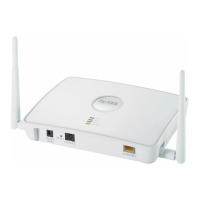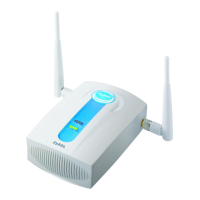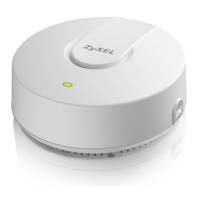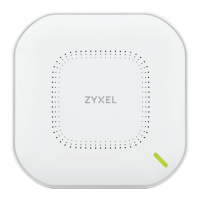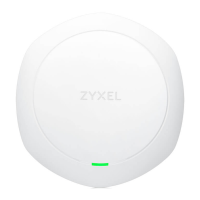Chapter 8 Wireless Screen
NWA-3160 Series User’s Guide
124
The following table describes the labels in this screen.
Table 23 Multiple BSS
LABEL DESCRIPTION
Operating Mode Select MBSSID in this field to display the screen as shown
802.11 Mode Select 802.11b Only to allow only IEEE 802.11b compliant WLAN
devices to associate with the NWA.
Select 802.11g Only to allow only IEEE 802.11g compliant WLAN
devices to associate with the NWA.
Select 802.11b+g to allow both IEEE802.11b and IEEE802.11g
compliant WLAN devices to associate with the NWA. The
transmission rate of your NWA might be reduced.
Super Mode Select this to improve data throughput on the WLAN by enabling
fast frame and packet bursting.
Choose Channel ID Set the operating frequency/channel depending on your particular
region. To manually set the NWA to use a channel, select a channel
from the drop-down list box. Click MAINTENANCE and then the
Channel Usage tab to open the Channel Usage screen to make
sure the channel is not already used by another AP or independent
peer-to-peer wireless network. To have the NWA automatically
select a channel, click Scan instead.
RTS/CTS Threshold Use RTS/CTS to reduce data collisions on the wireless network if
you have wireless clients that are associated with the same AP but
out of range of one another. When enabled, a wireless client sends
an RTS (Request To Send) and then waits for a CTS (Clear To Send)
before it transmits. This stops wireless clients from transmitting
packets at the same time (and causing data collisions).
A wireless client sends an RTS for all packets larger than the
number (of bytes) that you enter here. Set the RTS/CTS equal to or
higher than the fragmentation threshold to turn RTS/CTS off.
Fragmentation
Threshold
The threshold (number of bytes) for the fragmentation boundary for
directed messages. It is the maximum data fragment size that can
be sent. Enter an even number between 256 and 2346.
Beacon Interval When a wirelessly networked device sends a beacon, it includes
with it a beacon interval. This specifies the time period before the
device sends the beacon again. The interval tells receiving devices
on the network how long they can wait in low-power mode before
waking up to handle the beacon. This value can be set from 30ms to
1000ms. A high value helps save current consumption of the access
point.
DTIM Delivery Traffic Indication Message (DTIM) is the time period after
which broadcast and multicast packets are transmitted to mobile
clients in the Active Power Management mode. A high DTIM value
can cause clients to lose connectivity with the network. This value
can be set from 1 to 100.

